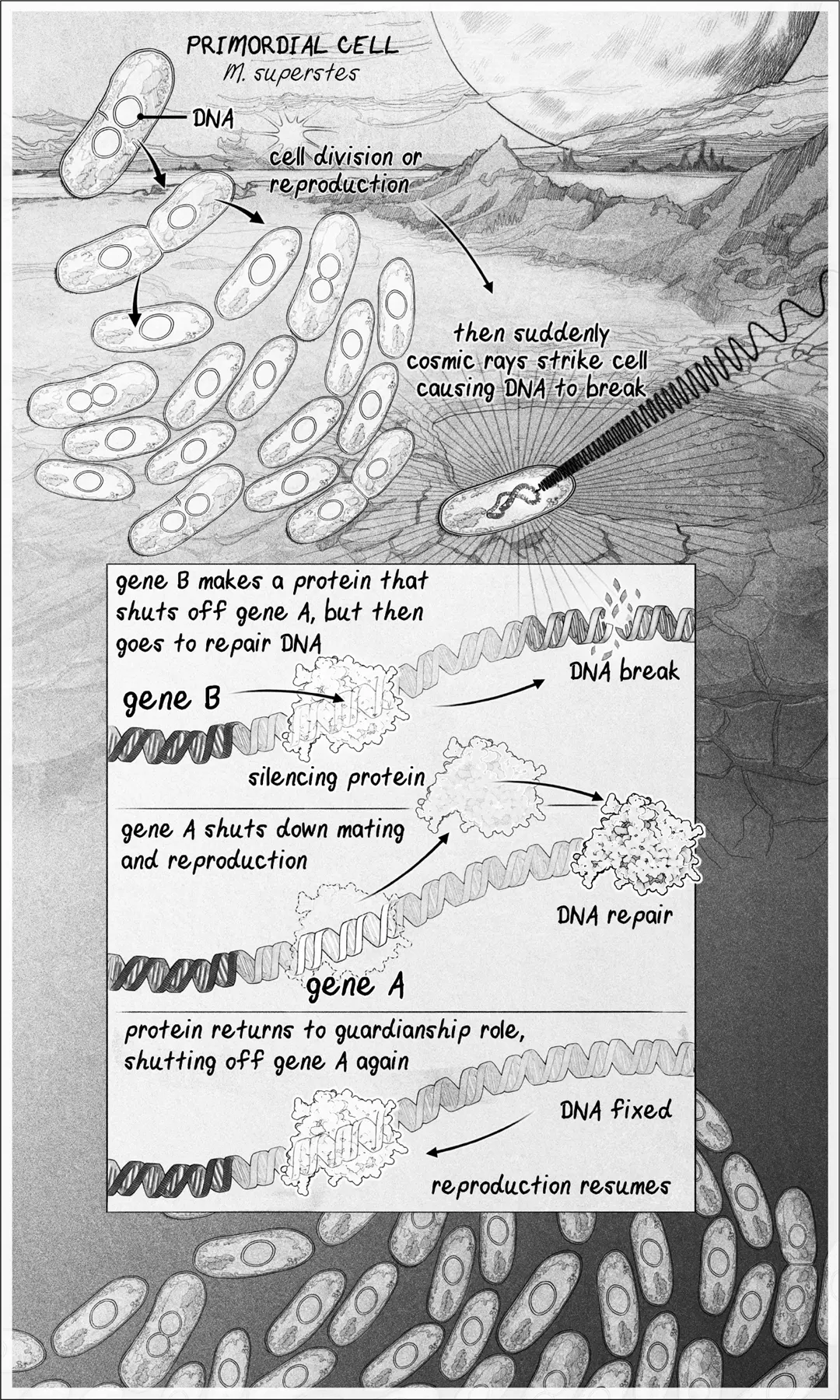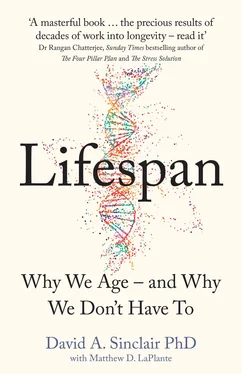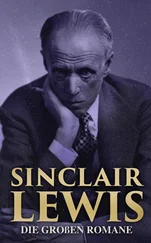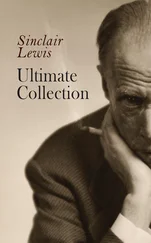PART I
WHAT WE KNOW
(THE PAST)
IMAGINE A PLANET ABOUT THE SIZE OF OUR OWN, ABOUT AS FAR FROM ITS STAR,rotating around its axis a bit faster, such that a day lasts about twenty hours. It is covered with a shallow ocean of salty water and has no continents to speak of—just some sporadic chains of basaltic black islands peeking up above the waterline. Its atmosphere does not have the same mix of gases as ours. It is a humid, toxic blanket of nitrogen, methane, and carbon dioxide.
There is no oxygen. There is no life.
Because this planet, our planet as it was 4 billion years ago, is a ruthlessly unforgiving place. Hot and volcanic. Electric. Tumultuous.
But that is about to change. Water is pooling next to warm thermal vents that litter one of the larger islands. Organic molecules cover all surfaces, having ridden in on the backs of meteorites and comets. Sitting on dry, volcanic rock, these molecules will remain just molecules, but when dissolved in pools of warm water, through cycles of wetting and drying at the pools’ edges, a special chemistry takes place. 17As the nucleic acids concentrate, they grow into polymers, the way salt crystals form when a seaside puddle evaporates. These are the world’s first RNA molecules, the predecessors to DNA. When the pond refills, the primitive genetic material becomes encapsulated by fatty acids to form microscopic soap bubbles—the first cell membranes. 18
It doesn’t take long, a week perhaps, before the shallow ponds are covered with a yellow froth of trillions of tiny precursor cells filled with short strands of nucleic acids, which today we call genes.
Most of the protocells are recycled, but some survive and begin to evolve primitive metabolic pathways, until finally the RNA begins to copy itself. That point marks the origin of life. Now that life has formed—as fatty-acid soap bubbles filled with genetic material—they begin to compete for dominance. There simply aren’t enough resources to go around. May the best scum win.
Day in and day out, the microscopic, fragile life-forms begin to evolve into more advanced forms, spreading into rivers and lakes.
Along comes a new threat: a prolonged dry season. The level of the scum-covered lakes has dropped by a few feet during the dry season, but the lakes have always filled up again as the rains returned. But this year, thanks to unusually intense volcanic activity on the other side of the planet, the annual rains don’t fall as they usually do and the clouds pass on by. The lakes dry up completely.
What remains is a thick, yellow crust covering the lake beds. It is an ecosystem defined not by the annual waxing and waning of the waters but by a brutal struggle for survival. And more than that: it is a fight for the future—because the organisms that survive will be the progenitors of every living thing to come: archaea, bacteria, fungi, plants, and animals.
Within this dying mass of cells, each scrapping for and scraping by on the merest minimums of nutrients and moisture, each one doing whatever it can to answer the primal call to reproduce, there is a unique species. Let’s call it Magna superstes . That’s Latin for “great survivor.”
It does not look very different from the other organisms of the day, but M. superstes has a distinct advantage: it has evolved a genetic survival mechanism.
There will be far more complicated evolutionary steps in the eons to come, changes so extreme that entire branches of life will emerge. These changes—the products of mutations, insertions, gene rearrangements, and the horizontal transfer of genes from one species to another—will create organisms with bilateral symmetry, stereoscopic vision, and even consciousness.
By comparison, this early evolutionary step looks, at first, to be rather simple. It is a circuit. A gene circuit.
The circuit begins with gene A, a caretaker that stops cells from reproducing when times are tough. This is key, because on early planet Earth, most times are tough. The circuit also has a gene B, which encodes for a “silencing” protein. This silencing protein shuts gene A off when times are good, so the cell can make copies of itself when, and only when, it and its offspring will likely survive.
The genes themselves aren’t novel. All life in the lake has these two genes. But what makes M. superstes unique is that the gene B silencer has mutated to give it a second function: it helps repair DNA. When the cell’s DNA breaks, the silencing protein encoded by gene B moves from gene A to help with DNA repair, which turns on gene A. This temporarily stops all sex and reproduction until the DNA repair is complete.
This makes sense, because while DNA is broken, sex and reproduction are the last things an organism should be doing. In future multicellular organisms, for instance, cells that fail to pause while fixing a DNA break will almost certainly lose genetic material. This is because DNA is pulled apart prior to cell division from only one attachment site on the DNA, dragging the rest of the DNA with it. If DNA is broken, part of a chromosome will be lost or duplicated. The cells will likely die or multiply uncontrollably into a tumor.
With a new type of gene silencer that repairs DNA, too, M. superstes has an edge. It hunkers down when its DNA is damaged, then revives. It is superprimed for survival.

THE EVOLUTION OF AGING.A 4-billion-year-old gene circuit in the first life-forms would have turned off reproduction while DNA was being repaired, providing a survival advantage. Gene A turns off reproduction, and gene B makes a protein that turns off gene A when it is safe to reproduce. When DNA breaks, however, the protein made by gene B leaves to go repair DNA. As a result, gene A is turned on to halt reproduction until repair is complete. We have inherited an advanced version of this survival circuit.
And that’s good, because now comes yet another assault on life. Powerful cosmic rays from a distant solar eruption are bathing the Earth, shredding the DNA of all the microbes in the dying lakes. The vast majority of them carry on dividing as if nothing has happened, unaware that their genomes have been broken and that reproducing will kill them. Unequal amounts of DNA are shared between mother and daughter cells, causing both to malfunction. Ultimately, the endeavor is hopeless. The cells all die, and nothing is left.
Nothing, that is, but M. superstes . For as the rays wreak their havoc, M. superstes does something unusual: thanks to the movement of protein B away from gene A to help repair the DNA breaks, gene A switches on and the cells stop almost everything else they are doing, turning their limited energy toward fixing the DNA that has been broken. By virtue of its defiance of the ancient imperative to reproduce, M. superstes has survived.
When the latest dry period ends and the lakes refill, M. superstes wakes up. Now it can reproduce. Again and again it does so. Multiplying. Moving into new biomes. Evolving. Creating generations upon generations of new descendants.
They are our Adam and Eve.
Like Adam and Eve, we don’t know if M. superstes ever existed. But my research over the past twenty-five years suggests that every living thing we see around us today is a product of this great survivor, or at least a primitive organism very much like it. The fossil record in our genes goes a long way to proving that every living thing that shares this planet with us still carries this ancient genetic survival circuit, in more or less the same basic form. It is there in every plant. It is there in every fungus. It is there in every animal.
Читать дальше













